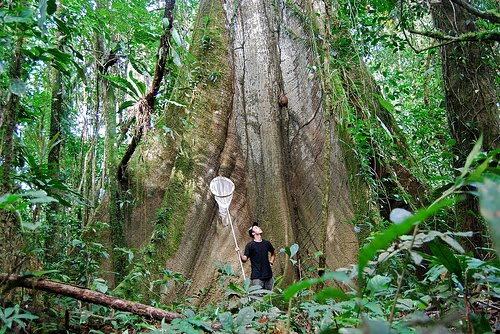Today I spent my first day at the Catholic University’s Yasuní Scientific Research Station in Yasuní National Park, after a hectic week of leaving Sacha Lodge for Quito in the Andes, and then back down to the Amazon basin. During my one month stay at Sacha, I nearly doubled my total count of butterflies during my month-long stay. Interestingly, I found that the species that were most common in both my traps and hand-net were quite different from those that I found in Jatun Sacha and Yarina, despite the three sites’ fairly close proximity to one another and their similar habitats. This can be due to a wide variety of factors. A species’ abundance changes throughout the year, in response to anything from host plant flowering to temperature and moisture cycles; this is even true in the relatively aseasonal western Amazon forests. However, different abundances can also be due simply to either local or more widespread distributional patterns; that is, perhaps certain species are more abundant in one place simply because their host plant is found there, or they were heavily parasitized in one place and not the other. Sometimes, historical or biogeographical causes might be responsible. The potential reasons underlying these observations are practically limitless, underscoring the difficulty ecologists face when trying to tease out patterns in abundance and distribution. For this reason, I am visiting as many sites in eastern Ecuador as possible, in order get the most robust picture of butterfly abundance possible.
Sacha Lodge itself was a wonderful place to spend a month. Situated right on Laguna Pilchicocha, close to the Rio Napo, and surrounded by water philodendrons and floating mats of grass, the setting is absolutely spectacular. The theme at the lodge is luxury, luxury, luxury, and guests are pampered in every way during their 4 or 5 day stay. Excursions include visits to a wooden tower built around a massive kapok tree, a 300 meter canopy walkway, trails through the rainforest, and canals to observe wildlife – monkeys, anacondas, and of course, loads of butterflies are just some of the things one might see (I saw all these and more). Naturally, I was quite lucky to stay at such an amazing place. In exchange for my stay, I helped a bit with their butterfly farm; current levels of production are relatively low, and I provided some advice how to increase efficiency and thus output. I also guided tourists again for a few days, again enjoying very much my time with my guests, a friendly group from Alberta, Canada.
 |
| Laguna Pilchicocha, near the Rio Napo |
 |
| Sacha Lodge |
 |
| Wildlife found in the laguna: hoatzins, or stinky turkeys |
 |
| Hamadryas arinome, seen from the wooden Kapok tower |
Yasuní National Park is a vast reserve in the northeastern corner of Ecuador, in the lowlands of western Amazonia. The park is a complex mixture of pristine tropical rainforest, oil fields, and indigenous lands. Both Kichwa and Waoarani indians live in and around the park, and unfortunately, the discovery of oil here has brought some extreme and very rapid changes. Repsol, which is, from what I’ve been told, an American oil company, built roads and oil platforms; they also provide the local Waoarani with everything they need – transportation, food, housing. One of the most important results of this situation has been a population explosion. In addition, a culture drastically different from the majority of other Ecuadorians (among other factors) has meant that the Waoarani have had a particularly difficult time adjusting to the enormous change imposed upon them. One of the most important questions to ask is what will happen to these people when the oil wells run dry, and the oil company goes packing? Will colonists invade and clear the forest for unsustainable farming and grazing, as is happening elsewhere throughout huge portions of the Amazon? Or will the Waoarani take over as stewards of their own land? We’ll see soon enough.





